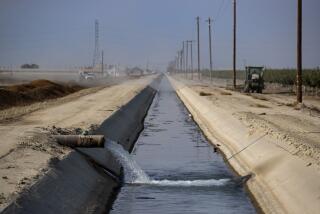Broader study of the Klamath Basin urged
SACRAMENTO -- — Wading anew into one of the West’s fiercest water wars, a scientific panel from the National Research Council said this week that a more comprehensive study needs to be done on the problem-plagued Klamath River Basin.
Past studies have focused only on the main river -- which has seen dams and water diversion hurt threatened salmon and suckerfish populations -- ignoring its many tributaries, the panel said in a report.
“It’s like trying to understand a tree by only examining its trunk and not assessing its branches,” said William L. Graf, a University of South Carolina geography professor and chairman of the committee of 13 scientists assembled to study the river by the council, an arm of the National Academies in Washington.
Graf said past research has been piecemeal and failed to grasp the “big picture” of the workings of the Klamath, which suffered a massive fish kill in 2002 that led to such low salmon returns by 2006 that a 700-mile swath of the Northern California and Oregon coast was largely closed to commercial fishing.
The report examined two key studies on how to manage river flows -- one produced by a Utah State University professor, the other by the U.S. Bureau of Reclamation -- and found positives and negatives to both on a variety of technical fronts.
To address the gap in scientific understanding, the committee recommended that researchers, government agencies and the various groups jousting over how to manage the Klamath work together with independent experts to produce a basin-wide plan for the ailing river. It should be free of politics while addressing land use and the effect of climate change, the panel said.
Those findings and conclusions came as no surprise to many of the groups that have warred over how to fix the river.
“We’ve known from the beginning that salmon and steelhead populations rely on the health of the entire river system, not just one segment,” said Rep. Mike Thompson (D-St. Helena), one of the leading congressional critics of the way the Bush administration has managed the river.
The panel also backed the Utah State study’s recommendation of higher water flows than those prescribed by federal water managers in a long-term plan for water diversion to farms.
One environmental group welcomed that finding as a way to help salmon.
“For years, the Bush administration and agribusiness have claimed Klamath salmon don’t need more water, and now the National Academy of Science has slammed the door on their arguments,” said Steve Pedery, of Oregon Wild.
The report marks the second time that the council has assembled a scientific panel to study the Klamath -- but the two groups reached far different conclusions on water flows. A report released in 2003 determined that increased flows were not justified to save endangered fish.
For years, a fight over the Klamath River has raged among farmers who divert the river waters, environmentalists and fishermen eager to protect declining salmon and steelhead populations, and Native American tribes that have seen the river’s decline affect their traditional way of life.
Meanwhile, four dams that block upper river spawning grounds are being targeted for removal by tribes and environmental groups. But earlier this month, a federal power agency recommended that they remain and that migratory fish be trucked around them.
Ongoing talks launched by the Bush administration more than two years ago are aimed at inking a deal that could tie dam removal to controversial Endangered Species Act concessions in the Klamath Basin, continued farming on a national wildlife refuge and sustained water diversions for agriculture.
More to Read
Sign up for Essential California
The most important California stories and recommendations in your inbox every morning.
You may occasionally receive promotional content from the Los Angeles Times.










